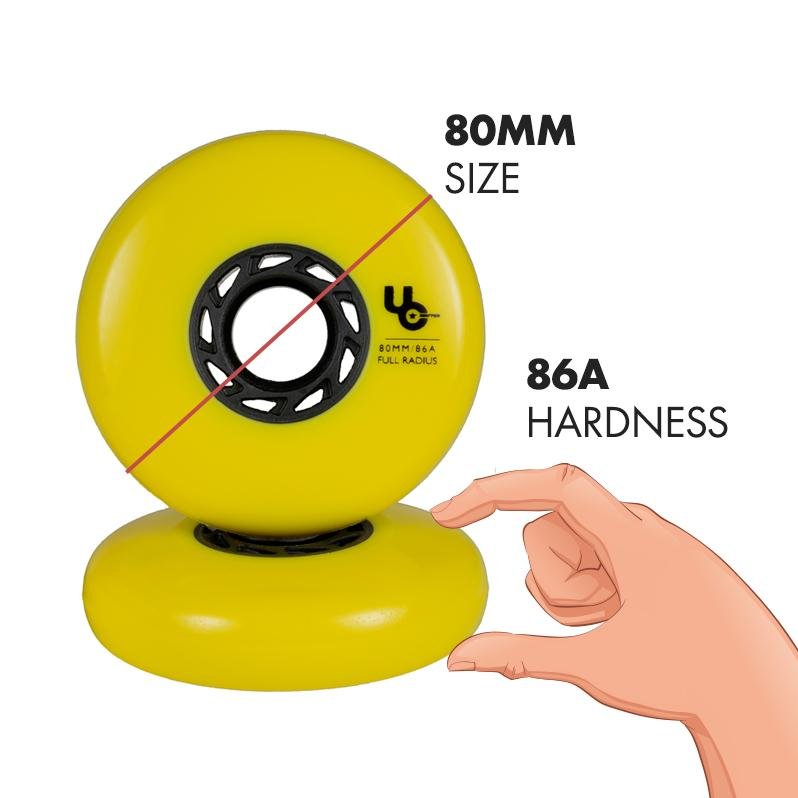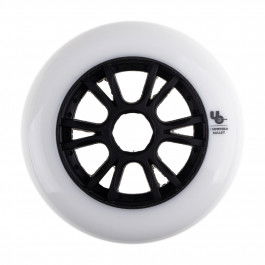Choosing proper inline skating wheels' hardness is crucial for good riding experience
Wheels made for inline skates come in different sizes, profiles, hardness, urethane blends, with different cores and with different purpose.
There are four most important characteristics of skate wheel:
- diameter (size) - given in millimeters (mm)
- profile - flat, curved or eliptical (bullet)
- rebound - High Rebound (HR), Super High Rebound (SHR), Ultra High Rebound (UHR)
- hardness - given as the value of "A", according to Shore's durometer hardness scale
Size of wheels depends on type of skates and maximum diameter their frames allow for. However, rest of the parameters can vary.
When it comes to profile, it is mostly a matter of individual preference. Bullet profile is the fastest, but least stable. Flat profile is slowest, but most stable. Curved (round) is a good middle ground between the two.
When it comes to rebound, there's one rule - higher rebound is always better, because it makes wheel "faster" - provides better acceleration. Also, you cannot make something like low quality UHR wheel - SHR and UHR levels of rebound both require really good urethane blends, which do not come cheap and have increased durability (and quite often, grip).
It is worth to note that these three urethane rebound categories are simplification. Wheels found in super cheap skates you can buy at your local supermarket will most likely have rebound and quality far below HR. A good quality wheel can have rebound placing it somewhere in between SHR and UHR. Also, when it comes to highest quality wheels made for speedskating, their urethane blends are kept in secret by manufacturers.
Hardness of a wheel is also a matter of preference, however certain skating styles do benefit from lower of higher hardness more than others. In most cases the hardness is printed on the surface of the wheel or given as a specification on the packaging or in the product description.
Hardness of inline-skate wheels
The higher the "A" value, the harder the wheel. Without going into much detail, we can state the following principles:
- the harder the wheels, the greater is their durability. Harder compound PU is resistant to abrasion and wears much more slowly when braking or making slides. Important note here - this applies to wheels of matching quality and similar other specs. For example, Ultra High Rebound wheel with 88A hardness will be more durable than 84A one if both come from the same manufacturer and are roughly the same when it comes to other characteristics.
- the harder the wheel, the less grip it have. In general, hard wheels have smaller contact surface compared to softer ones of the same profile. It is worth to note that this does not scale in linear fashion and level of perceived grip differs for people of different weight or skating styles.
- harder wheels are faster. Smaller contact surface means less friction and roll resistance.
- harder wheels dampen vibrations much worse. Skating on uneven and rough surfaces with wheels of a lower hardness is much more comfortable.

These principles can be seen as universal for all kinds of wheels, but keep in mind that the characteristics and properties of the wheel does not only depend on the "A" ranking, but also:
- The shape, structure and size of core (hub). Some hubs are very rigid, made to withstand jumps. Others are more flexible, made to increase rebound - most often found in speedskating wheels.
- Additional technological solutions used in the construction. Highest quality speedskating wheels have double-layer construction, with softer strip of urethane beneath outer cover of harder one. This increases rebound.
- Age of the wheels - like all synthetic composites, polyurethane does degrade over time, with its' molecular network slowly collapsing. This happens especially if wheels were stored in warm environment and not properly sealed. Exposure to sunlight also "hurts" them. A 20 years old wheel which was top-tier back then may fall apart on a first ride!
Remember what we wrote about wheels with identical parameters but different hardness? Well, it does cut both ways. Two wheels with the same urethane blend and the same hardness will behave differently based on their cores and profile.
How to choose hardness of inline skating wheels?
We have already covered majority of the subject, but how does this knowledge apply in practice? See below!
- Hardness under 80 A - wheels designed for very smooth surfaces like parquet or when there's a requirement for increased grip. Very soft wheels are quite often used in indoor inline hockey and in recreational skates for children - as they weight less and need softer wheels for comfortable ride, seeing that urethane does not bend under them that much.
- 80 – 84 A – standard hardness range of wheels used in recreation and fitness. Such wheels are characterized by average speed, good grip, and decent vibration dampening, making the ride comfortable.
- 83/84 – 87/88A– used primarily in the disciplines that require fast and wear resistant wheels: freestyle slalom, freeride/urban skating, speed skating.
- Above 87/88A up to 95A – such wheels are used primarily in aggressive skating, but sometimes are seen in freeride. Skaters who use this type of wheels are aware of the low-grip, have technique adjusted to it and can even use it to their advantage (slides). Hard wheels are bread and butter of skating street in aggressive style, as they have uncreased durability and lifespan. They also are less likely to cause "wheel bite" during grinds.
Some wheels don't have "A" hardness parameter - why?
One must be aware that Shore's scale of hardness is too imprecise when it comes to comparing wheels of different manufacturers. Thus, 84A wheel of one company can feel different from 84A wheel of another, even if they have similar cores and profiles.
Seeing that Shore's durometer hardness scale isn't that precise even when it comes to give information about different wheels made by the same company, some brands have abandoned it and created their own indicators to make choice of wheels easier.
A good example here is Matter, which uses "F" scale, where "F" stands for footprint. It is very easy to measure - they simply press the wheels against the same surface, using the same forse and then measure area of contact. Thus, the lower the footprint, the harder the wheel. The hardest wheels in Matter catalogue have F0 parameter, but most models come in F1 flavour. There's also F2 type, but these are rather uncommon.
Another company which developed its' own scale is MPC. They make wheels intended for different skating conditions (i.e. track, street, wet weather) and offer them in up to three different specs. "Firm" is the softest wheel, made for very rough surfaces (when you need shock dampening) or very slick ones (when you need good grip). X-Firm wheels are intended for optimal conditions - hard, smooth and dry surfaces. XX-Firm are hardest of the bunch and made for skaters who want best roll.
Okay, so how should I pick next set of wheels?
If you want to buy your first set of wheels for replacement, it is good to take hardness of stock wheels as a point of reference.
For example, if you have higher tier Powerslide fitness skates which came with Infinity II wheels of 85A hardness and feel that you want something softer, you can go for 82A ones made by the same brand or other with good reputation, such as K2, Rollerblade or FR.
Want something faster and harder? Give Powerslide Spinners 88A a shot (solid medium tier wheels), or maybe go all in and pick top tier Undercovers in 86A.
Also, always take your skating technique, weight and type of surface you skate most often on into account when choosing wheel hardness.
Someone who is doing urban skating, go fast through the city on varied surfaces, needs reliable, durable wheels, but not too hard as it can cause slip-outs. Thus, in this scenario, it is worth to pick ones of 86A-88A hardness. If you are weighting significantly more than average (i.e. you've build up muscle mass at gym), you may want to try 90A wheels.
Another scenario: a small frame girl who is mainly doing freestyle slalom on parquet shouldn't really go for something harder than 85A and even this can be a stretch - something like 82A-84A is preferable.
We could go on and on. Point is - before purchase, define your needs and preferences first.
You can find our selection of wheels for all types of skating here.



























